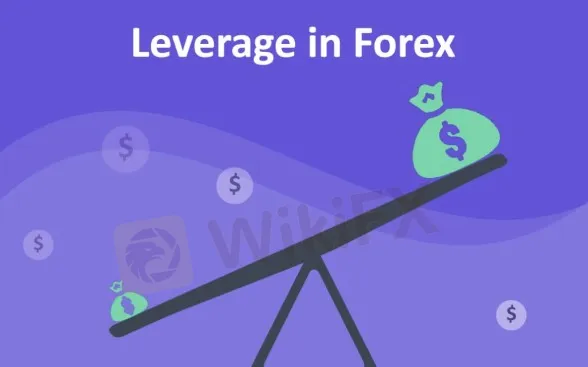简体中文
繁體中文
English
Pусский
日本語
ภาษาไทย
Tiếng Việt
Bahasa Indonesia
Español
हिन्दी
Filippiiniläinen
Français
Deutsch
Português
Türkçe
한국어
العربية
WikiFX Education: How to Take Advantage of the Forex Leverage?
Abstract:The following article describes the risks of high leverage in the forex market and summarizes ways to offset risky leverage levels.

To understand how to trade Forex, we need to have a detailed understanding of the economic and political conditions of each country, the global macroeconomy, and the impact of market volatility on a particular market. But the truth is that it is not usually the economy or global financial fluctuations that confuse Forex traders. Rather, a lack of basic knowledge of how to use leverage is often the root cause of trading losses
According to statistics from the largest forex brokers, most retail forex clients are losing money. The misuse of leverage is often cited as the cause of these losses. The following article describes the risks of high leverage in the forex market and summarizes ways to offset risky leverage levels.
High Leverage Gets Risky
Leverage refers to the process by which an investor borrows money to invest or buy something. In forex trading, funds are usually obtained from a broker. Although Forex traders can borrow large amounts of money based on initial margin requirements, they can make more profit from successful trades.
In the past, many brokers were able to offer high leverage ratios of up to 400:1. This meant that by depositing as little as $250, a trader could control approximately $100,000 in the global foreign exchange market. However, in 2010 financial regulations limited the leverage offered by brokers to U.S. traders to 50:1 (which is still quite large). This means that with the same $250 deposit, a trader can control $12,500 of currency.
How to Choose the Right Level of Leverage?
Before choosing a leverage level, investors should review the generally accepted rules. The three simplest rules of leverage are:
1. Keep the leverage level low;
2. Use a stop loss to reduce downside and protect capital;
3. Limit the capital of each position to 1% to 2% of the total trading capital.
Forex traders should choose the level of leverage they feel most comfortable with. If you are conservative and don't like to take risks, or if you are still learning how to trade currencies, then a lower leverage ratio (e.g. 5:1 or 10:1) may be more appropriate.
Trailing or limited stops provide a reliable way for investors to cut their losses if a trade goes wrong. By limiting stops, investors can ensure that they can continue to learn how to trade currencies, but they can limit potential losses if the trade fails. These stops are also important because they help reduce trading emotions and allow individuals to leave the trading desk without emotion.
Choosing the appropriate level of Forex leverage depends on the trader's experience, risk tolerance and comfort level in operating in the global currency markets. New traders should familiarize themselves with the terminology and remain conservative in learning how to trade and gain experience. Using stops, keeping positions small and limiting the amount of capital in each position is a good start to learning proper leverage management practices.
More Forex Knowledge at WikiFX
WikiFX is a global broker regulatory inquiry app that holds information of over 35,000 forex brokers in collaboration with 30 national regulators. Here, traders can find verified details of a certain forex broker before engaging with them. In addition to this, you can also see more forex news. Visit WikiFX's official website at www.wikifx.com.

Alternatively, download the free WikiFX app on Google Play/App Store.

Disclaimer:
The views in this article only represent the author's personal views, and do not constitute investment advice on this platform. This platform does not guarantee the accuracy, completeness and timeliness of the information in the article, and will not be liable for any loss caused by the use of or reliance on the information in the article.
Read more

Mastering Support and Resistance in Forex Trading Success
Know why support and resistance levels are crucial in Forex trading, the best tools to identify them, and how they impact trading success.

Hidden Forex Fees That Can Drain Your Profits
Many traders focus on profits when entering the forex market. However, the costs of trading can silently eat into those profits. Brokers often advertise low fees and tight spreads, but hidden costs can add up. Understanding these fees is crucial for managing your trading expenses.

Why Do Some Brokers Block Your Withdrawals?
Withdrawal issues are among the most frustrating experiences for traders. Many brokers operate smoothly, but some delay or refuse to release funds. These delays can be stressful, especially for traders who rely on timely access to their profits. Understanding why brokers act this way can help you avoid falling victim to such situations.

Woman Scammed Out of RM200,000 in Investment Fraud
A 54-year-old vegetable trader from Tepoh, Kuala Nerus, was scammed out of RM214,700 after falling for a fraudulent investment scheme advertised on Facebook. The victim was lured by promises of quick, high returns with minimal investment
WikiFX Broker
Latest News
Top Regulated Forex Brokers with Prop Trading Options
Forex Regulators Around the World: Who’s the Strictest?
What Happens When a Broker Goes Bankrupt?
Woman Scammed Out of RM200,000 in Investment Fraud
XS.com Launches AI Insights to Transform Trading Behavior
Why Do Some Brokers Block Your Withdrawals?
FCA Cautions Against ALT-COINFX
Unlocking the Secrets of Prop Trading: How to Succeed in Proprietary Trading Firms
Tether’s $13B Profits in 2024 Amid UK Regulatory Scrutiny
Philippine Authorities Bust Manila Online Scam Farm, Arrest 100
Currency Calculator







